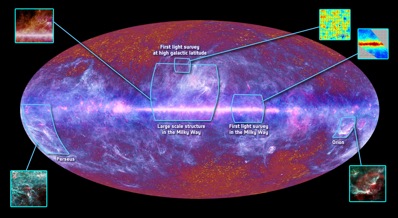


|

|
 |
|
Planck unveils first all-sky map of Universe DR EMILY BALDWIN ASTRONOMY NOW Posted: 5 July 2010 The much anticipated first all-sky microwave map of the Universe from ESA's Planck mission has today been unveiled. “This is the moment that Planck was conceived for,” says ESA Director of Science and Robotic Exploration, David Southwood. “We’re not giving the answer. We are opening the door to an Eldorado where scientists can seek the nuggets that will lead to deeper understanding of how our Universe came to be and how it works now. The image itself and its remarkable quality is a tribute to the engineers who built and have operated Planck. Now the scientific harvest must begin.”  Planck's view of the microwave sky, covering frequencies from 30 GHz to 857 GHz. Notable features have been highlighted. Click for larger image. Image: ESA/LFI & HFI Consortia. Planck's view of the microwave sky, covering frequencies from 30 GHz to 857 GHz. Notable features have been highlighted. Click for larger image. Image: ESA/LFI & HFI Consortia.
The main disc of our Galaxy, the Milky Way, streaks through the centre of the image, with streamers of cold dust arching high above and below the Galaxy, knitted together to create a 'galactic web' bursting with new stars. At the top and bottom of the image the mottled backdrop of the cosmic microwave background (CMB) radiation shines through. The oldest light in the Universe, this speckled pattern is the ghostly remains of the big bang that blasted the Universe into existence 13.7 billion years ago. The different colours in the CMB represent minute differences in temperature and density of matter that mark the spots from which today's structure – i.e. galaxies – evolved. One of the most anticipated results from Planck will be whether the data will expose the signature of a period of cosmic time called inflation, whereby the Universe expanded rapidly during the very first moments of existence. Over the next several hundred million years the higher density regions condensed into stars and galaxies. The CMB is thus a cosmic blueprint of the Universe, from which Planck will decode how these early 'lumps and bumps' took on today's shape. The majority of the CMB radiation is drowned out in this image by the Milky Way's emission, but the data will be reduced to reveal the CMB in its entirety, in the most precise picture of the CMB ever obtained. By the time the Planck mission concludes in 2012 it will have completed four all-sky scans. “This image is just a glimpse of what Planck will ultimately see,” says Jan Tauber, ESA’s Planck Project Scientist. |
|
|
|
|